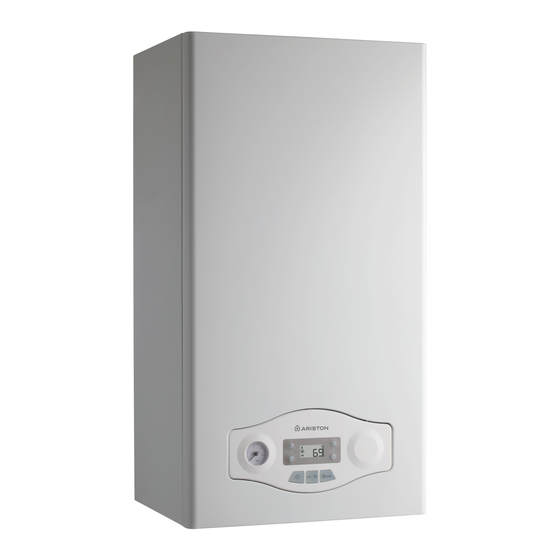Ariston EGIS PREMIUM Series Instrucciones de instalación y mantenimiento - Página 38
Navegue en línea o descargue pdf Instrucciones de instalación y mantenimiento para Caldera Ariston EGIS PREMIUM Series. Ariston EGIS PREMIUM Series 40 páginas. Condensing wall-hunh gas boiler

manutenzione
Prova di funzionamento
Dopo aver eff ettuato le operazioni di manutenzione, riempire il
circuito di riscaldamento alla pressione di circa 1,2 bar e sfi atare
l'impianto.
Riempire anche l'impianto sanitario.
- Mettere in funzione l'apparecchio.
- Se è necessario sfi atare nuovamente l'impianto di riscaldamento.
- Verifi care le impostazioni e il buon funzionamento di tutti gli
organi di comando, regolazione e controllo.
- Verifi care la tenuta e il buon funzionamento dell'impianto di
evecuazione fumi/prelievo aria comburente.
Operazioni di svuotamento
Lo svuotamento dell'impianto di riscaldamento deve essere eseguito
nel seguente modo:
- spegnere la caldaia e portare l'interruttore bipolare esterno in
posizione OFF e chiudere il rubinetto del gas;
- allentare la valvola automatica di sfogo aria;
- aprire il rubinetto di scarico dell'impianto raccogliendo in un
contenitore l'acqua che fuoriesce;
- svuotare dai punti più bassi dell'impianto (dove previsti).
Se si prevede di tenere l'impianto fermo nelle zone dove la temperatura
ambiente può scendere nel periodo invernale al di sotto di 0°C, si
consiglia di aggiungere liquido antigelo all'acqua dell'impianto di
riscaldamento per evitare ripetuti svuotamenti; in caso di impiego
di tale liquido, verifi carne attentamente la compatibilità con l'acciaio
inox costituente il corpo caldaia.
Si suggerisce l'impiego di prodotti antigelo contenenti GLICOLE
di tipo PROPILENICO inibito alla corrosione (come ad esempio il
CILLICHEMIE CILLIT CC 45, il quale è atossico e svolge una funzione
contemporanea di antigelo, antincrostante ed anticorrosione) nelle
dosi prescritte dal produttore, in funzione della temperatura minima
prevista.
Controllare periodicamente il pH della miscela acqua-antigelo del
circuito caldaia e sostituirla quando il valore misurato è inferiore al
limite prescritto dal produttore dell'antigelo.
NON MESCOLARE TIPI DIFFERENTI DI ANTIGELO.
Il costruttore non risponde dei danni causati all'apparecchio o
all'impianto dovuti all'utilizzo di sostanze antigelo o additivi non
appropriati.
Svuotamento impianto sanitario
Ogni qualvolta esista pericolo di gelo, deve essere svuotato l'impianto
sanitario nel seguente modo:
- chiudere il rubinetto della rete idrica;
- aprire tutti i rubinetti dell'acqua calda e fredda;
- svuotare dai punti più bassi (dove previsti).
ATTENZIONE
Svuotare i componenti che potrebbero contenere acqua calda,
attivando eventuali sfi ati, prima della loro manipolazione.
Eff ettuare la disincrostazione da calcare di componenti attenendosi
a quanto specifi cato nella scheda di sicurezza del prodotto usato,
aerando l'ambiente, indossando indumenti protettivi, evitando
miscelazioni di prodotti diversi, proteggendo l'apparecchio e gli
oggetti circostanti.
Richiudere ermeticamente le aperture utilizzate per eff ettuare letture
di pressione gas o regolazioni gas.
Accertarsi che gli ugelli siano compatibili con il gas di alimentazione.
Nel caso si avverta odore di bruciato o si veda del fumo fuoriuscire
dall'apparecchio o si avverta forte odore di gas, togliere
l'alimentazione elettrica, chiudere il rubinetto del gas,
aprire le fi nestre ed avvisare il tecnico.
38
maintenance
Operational test
After having carried out the maintenance operations, fi ll the heating
circuit at a pressure of approximately 1.2 bar and release the air from
the system.
Fill the domestic hot water system at the same time.
- Begin operating the boiler.
- If necessary, release the air from the heating system again.
- Check the settings and make sure all the command, adjustment
and monitoring parts are working correctly.
- Check the fl ue system is sealed and operating correctly.
Draining procedures
The heating system must be drained using the following procedure:
- Switch off the boiler, make sure the external bipolar switch is in the
OFF position and shut off the gas valve;
- Loosen the automatic air relief valve;
- Open the system drain off cock and collect the escaping water in a
container;
- Empty the water from the lowest points of the system (where
applicable).
If the system is to be left inactive in areas where the room temperature
may fall below 0°C during winter, we recommend that anti-freeze
liquid is added to the water in the heating system in order to avoid
the need for repeated draining; when this liquid is used make sure it
is compatible with the stainless steel used for the bodywork of the
boiler.
We recommend the use of anti-freeze products which contain
PROPYLENE GLYCOLS as these inhibit corrosion and that they are
used in conjunction with the anti-scaling and anti-corrosion function,
in the quantities suggested by the manufacturer, at the mimimum
temperature.
Regularly check the pH level of the water/anti-freeze mix in the boiler
circuit and replace it when the value measured is lower than the limit
prescribed by the manufacturer.
DO NOT MIX DIFFERENT TYPES OF ANTI-FREEZE.
The manufacturer will not be held liable for any damage caused by
the appliance or the system due to the use of inappropriate anti-
freeze substances or additives.
Draining the domestic hot water system and indirect cylinder
Every time there is a danger of freezing, the domestic hot water
system must be drained as follows:
- Shut off the water mains inlet valve;
- Open all the hot and cold water taps;
- Empty the water from the lowest points of the system (where
applicable).
WARNING
Before handling, empty all components which may contain hot
water, performing bleeding where necessary.
Descale the components in accordance with the instructions
provided on the safety data leafl et supplied with the product used,
make sure the room is well ventilated, wear protective clothing,
avoid mixing diff erent products, and protect the appliance and
surrounding objects.
Seal all openings used to take a gas pressure reading or to make any
gas adjustments.
Make sure that the nozzle is compatible with the supplied gas.
If a smell of burning is detected or smoke is seen leaking from the
appliance, or there is a smell of gas, disconnect it from the electricity
supply, shut off the gas valve, open the windows and call for technical
assistance.
